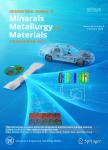Mechanical properties and kinetics of thermally aged Z3CN20.09M cast duplex stainless steel
Mechanical properties and kinetics of thermally aged Z3CN20.09M cast duplex stainless steel作者机构:School of Materials Science and Engineering University of Science and Technology Beijing School of Materials Science and Engineering Jiangxi University of Science and Technology State Key Laboratory of Nuclear Power Safety Monitoring Technology and Equipment China Nuclear Power Engineering Co. Ltd.
出 版 物:《International Journal of Minerals,Metallurgy and Materials》 (矿物冶金与材料学报(英文版))
年 卷 期:2018年第25卷第10期
页 面:1148-1155页
核心收录:
基 金:financially supported by the China General Nuclear Power Group
主 题:stainless steel thermal aging embrittlement activation energy microhardness Charpy impact energy
摘 要:Cast stainless steels used in nuclear power plants suffer from fracture toughness losses owing to thermal aging after long-term service at temperatures ranging from 280–320°C. To study the thermal aging embrittlement of Z3 CN20.09 M duplex stainless steel produced in China, accelerated thermal aging experiments were carried out at 350, 380, and 400°C for up to 10000 h. Microhardness and Charpy impact energies were measured at different aging times. The microhardness of ferrite increased drastically over the initial aging time of 2000 h at 380 and 400°C and then slowly reached HV0.01 560. In contrast to this observed change in microhardness, Charpy impact energies sharply decreased after initial aging and then gradually reached a minimum value. Taking the microhardness of the ferrite phase as the parameter describing the thermal kinetics of the stainless steel samples, the activation energy of thermal aging was calculated to be 51 kJ/mol. Correlations between the thermal aging parameter, P, and ferrite microhardness and between P and Charpy impact energy were also analyzed. The results showed that the activation energy calculated from the ferrite microhardness is much more reasonable than that obtained using other parameters, such as chemical composition and impact energy.



